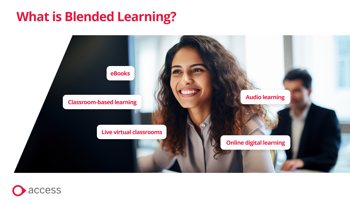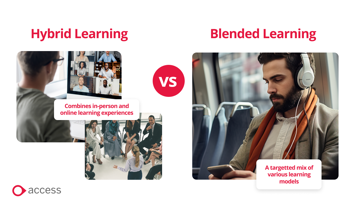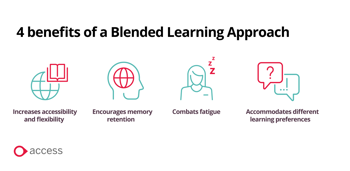 Access Bookboon
Access Bookboon
What is Blended Learning in the workplace? 4 key benefits of blended learning explored
To successfully upskill employees, organisations must strike a balance between the selection of learning materials and the methods of delivery. Utilising blended learning in the workplace ensures that various learning preferences are effectively addressed.
In this article, we are going to explore the blended learning approach, provide examples of popular solutions and look at four benefits of blended learning in business.
- Defining blended learning
- What is Blended Learning in the workplace?
- What is the difference between hybrid and blended learning?
- Why should you introduce blended learning in the workplace?
- Workplace Blended Learning Examples
- 4 benefits of a Blended Learning approach
- Why blended learning solutions should be part of your L&D strategy
Defining blended learning
Blended learning is the process of using a variety of different methods to deliver learning. Initially, it referred to the combination of traditional classroom-based learning and online digital learning (also known as eLearning), but the term has since evolved to include other digital formats such as:
Getting the most benefit out of the blended learning approach means choosing the right method of learning to suit both the preferences and needs of the learners and the content that is being delivered. Removing the sole reliance on fixed in-person training at specific times helps make learning more accessible, convenient and targeted.

What is Blended Learning in the workplace?
Blended learning in the workplace is using the above methods to assist with learning initiatives across an organisation.
Utilising blended learning in business means understanding the Learning and Development needs of your workforce and allocating the right type of training to your learners. For instance, consider an employee seeking to acquire new soft skills for increased adaptability in their role. Promoting a culture of self-directed learning will create a well-rounded learning experience, such as a set of eBooks around communication skills or bitesize learning modules on soft skills in the workplace.
For both large and small businesses, blended training can be a great opportunity to tailor learning to be most appropriate for your learners while still meeting the demands of providing learning at scale. To achieve this effectively, a sophisticated Learning Management System can be used to facilitate the assignment, tracking and management of the learning activities at the organisational, group or individual levels, ensuring development opportunities are targeted and engaging for the learner.
What is the difference between hybrid and blended learning?
While the two terms are often used interchangeably, there is a distinct difference between them. Understanding the nuances between them can help you make the right decision on what type of learning is most suited to the needs of your organisation.
What is hybrid learning?
Hybrid learning is a method of learning which combines in-person and online learning experiences. It can involve a mix of traditional classroom sessions and virtual activities or resources, usually presented alongside each other.
What is blended learning?
Blended learning is a broader term which encompasses both traditional, in-class, instructor-led training with online, self-paced content in various formats for flexible and targeted training.
The key distinction between these two terms is that hybrid learning implies a mix of in-person and online components, while blended learning can involve a mix of various learning models most suited to the learner, or targeted group of learners.

Why should you introduce blended learning in the workplace?
Although blended learning is certainly not a new concept, its significance has been highlighted by the evolving landscape of the workforce. Organisations are truly recognising the need for adaptability and upskilling to ensure employee satisfaction and productivity.
CIPD recently reported that 83% of organisations experienced difficulties recruiting, and upskilling existing employees was their most common response. Faced with such widespread recruitment challenges, organisations need efficient and accessible upskilling solutions. Blended learning, with its ability to deliver training remotely and on-demand, while also facilitating practical, hands-on learning, directly addresses this need. Therefore, digital-focused initiatives such as blended learning should be a key factor in L&D strategies in 2025 and beyond.
Workplace Blended Learning Examples
Now let’s look at how blended learning solutions can be applied within the workplace. Below are five examples of blended learning solutions.
Audio learning
Audio learning is the process of listening to audio to take in relevant information. It usually involves podcasts or audiobooks to deliver learning. The approach elevates the learning experience by providing learning on demand without the restraints of a classroom and it can be accessed when the learner is on the go, making learning very easy to fit in.
eBooks
eBook learning seamlessly integrates the convenience of digital books with a diverse range of topics, spanning topics such as leadership, development, mental health, and wellbeing. This approach provides a portable way for absorbing knowledge, combining the accessibility of electronic devices with rich educational content.
Online courses
Online courses are learning programmes delivered through the internet on a variety of topics. This blended learning method utilises a mix of media formats such as video, animations, and text resources, and often include knowledge assessments, delivering results upon completion.
Live virtual classrooms
Live virtual classrooms combine the flexibility of learning online from anywhere, the engaging interaction of live online learning and the structure of traditional classroom experiences. Crafted and presented by subject matter experts, these live virtual classrooms enable users to participate in real-time, fostering direct interaction.
Gamification
Gamified learning uses elements of gaming to share important learning content in a fun and engaging way. The use of short quizzes and friendly competition encourages both participation and interaction.
The breadth and standard of learning content we provide as employers reflects the value we place on our employees, their time and what they want out of their learning. Even if it’s compliance training like information security for example, or top-down learning, if you make it meaningful and more specific to your organisation and learners, we know that people engage with it more, get more value and are more likely to remember it.

4 benefits of a Blended Training approach
At its core, blended learning brings different learning resources together to create optimal impact. Below are four benefits of blended learning explored in more detail.
1. Increases accessibility and flexibility
Unlike using just traditional classroom learning, utilising a blended learning approach significantly enhances accessibility by breaking down geographical and time constraints. With the integration of online components, learners can access course materials from virtually anywhere, provided they have an internet connection.
Additionally, content can be revisited as needed and materials can be reviewed at the suitable pace of the learner. This adaptability ensures that individuals with varying learning preferences can navigate the educational material in a way that suits them best.
2. Encourages memory retention
The integration of multimedia elements, such as videos, quizzes, and interactive simulations, provides a multisensory experience, appealing to visual, auditory, and tactile learners.
An example of this is compliance training where there is a lot of important information that may be critical and time sensitive. Offering this in a bitesize format that is easy to understand makes it likely to stick in the learner’s memory.
3. Combats fatigue
By introducing different elements, blended learning encourages active participation, fosters a sense of accomplishment through achievement badges or points, and provides immediate feedback, keeping learners motivated and attentive.
This taps into the natural inclination for competition and achievement, creating a more dynamic learning environment that helps sustain interest and focus throughout the journey.
4. Accommodates different learning preferences
A workforce full of diverse employees is usually a strong one, so accommodating to different learning preferences is necessary.
Doing so ensures that learning is delivered in the most suitable way - some learners absorb learning through eBooks, while others find listening to audiobooks is the most effective approach.
Providing different learning delivery methods will help cater to all types of people.
Why blended learning solutions should be part of your L&D strategy
As we have discussed, utilising a blended learning approach will help cater to different types of learning preferences and ensure that individuals are learning in a way that suits them most. Whether it is by short bursts of bitesize training in the form of a quiz or getting stuck into an eBook, there are plenty of different ways that blended learning can benefit your organisation and workforce alike.
To find out more about the different formats of Digital Learning that can help you fulfil a blended learning approach contact our knowledgeable team and explore our wide range of solutions, including:
- On-demand learning empowers your workforce to upskill at their own pace with different types of learning formats.
- Our wide range of eLearning modules use multimedia, animation and videos to provide engaging learning experiences.
- Our gamification platform Gamebrain offers fun and friendly competition to encourage participation and engagement.
- Our Learning Management System Access LMS Evo delivers a variety of different training formats on a sleek platform designed to ignite a joy for learning
Related reading
Here's some articles you may find useful.

 AU & NZ
AU & NZ
 SG
SG
 MY
MY
 US
US
 IE
IE












